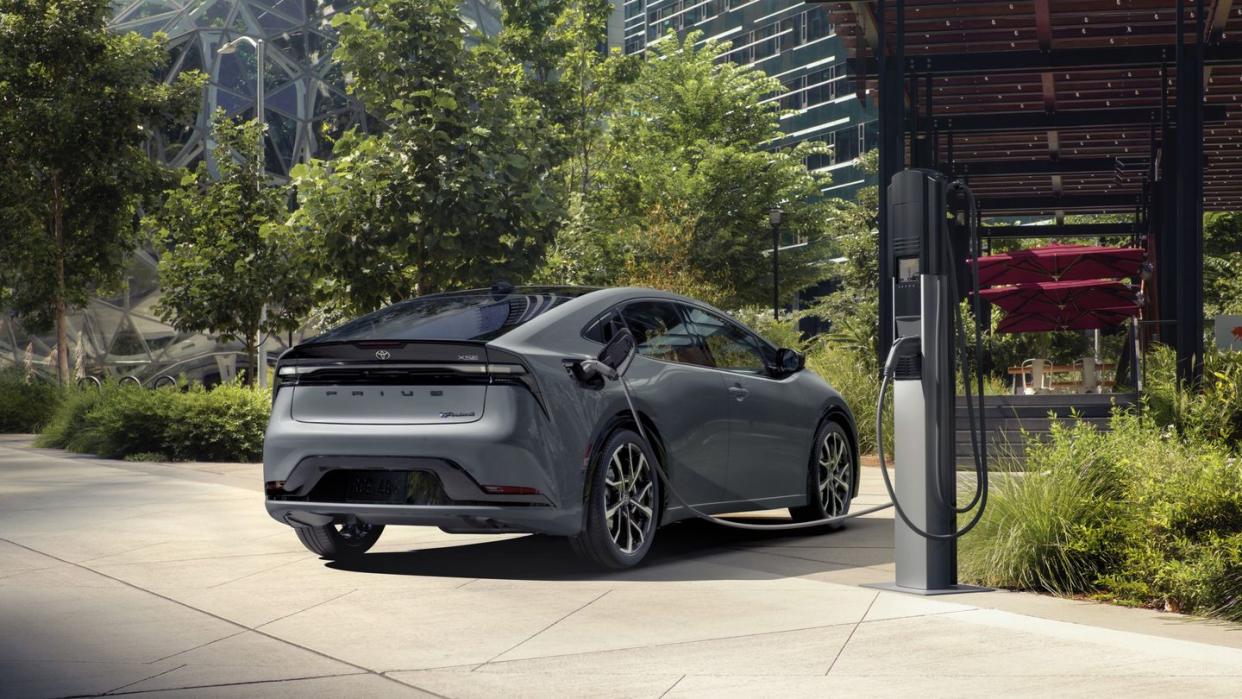What Happens If You Never Charge Your Plug-In-Hybrid Car?

After 25 years on the market, most people know what a hybrid car is—even if the only one they can name is the Toyota Prius. And battery-electric vehicles are simple: plug in them to charge the battery, and it will power the car for a few hundred miles.
But what happens if a plug-in hybrid doesn't get plugged in? TL, DR: Nothing.
More specifically, it continues to operate just like a regular hybrid. Its larger battery makes it heavier than a comparable hybrid, but it may also offer a bit more electric assistance and quicker acceleration as a tradeoff.
Hybrid? EV? Both? Neither?
But plug-in hybrids can be confusing for shoppers. Are they regular hybrids? Are they electric cars? Well, both and neither. Which all but guarantees that many car shoppers, let alone salespeople, don't really understand them—and sometimes don't know what they've bought.
The basic principle is that, when plugged in to charge its battery, a plug-in-hybrid electric vehicle (PHEV) can operate as an EV for 20 to 50 miles—which is often enough to cover your daily driving. (The average U.S. driver covers about 30 miles a day.) But it also has an engine and gas tank that provide a few hundred miles of additional range after the electric-only miles are used up. That makes them also excel on extended road trips, where you can just keep filling the gas tank and not worry about stopping for the lengthy recharging stops that EVs require.
A PHEV battery has a much lower capacity than that of a battery-electric vehicle—on average, about one-sixth the energy of an EV's battery—meaning the battery is less expensive to build. Its lesser energy also means a PHEV is fairly fast to recharge, often as few as two or three hours from a 240-volt (Level 2) charging station. Even plugged into a 120-volt household wall outlet, many PHEVs can recharge overnight.
Many plug-in hybrids are adapted from regular hybrids without a plug. One example: the 2024 Toyota Prius is a conventional hybrid, but the Prius Prime (which looks all but identical and is pictured at top) is a plug-in hybrid with up to 44 miles of EPA-rated electric range.
No Plugging In, No Problem?
Unlike battery-electric cars, PHEVs don't have to be plugged in to run. If the PHEV battery is "depleted," or has discharged its all-electric range, a portion of its capacity stays in reserve to act as a regular hybrid battery. That means the vehicle will recharge it via regenerative braking or by siphoning power from the engine. Even in this mode, some PHEVs (not all) can let their batteries charge to a higher capacity than the limited energy in the conventional hybrid. For example, they may regain one to four miles of pure electric range while descending a long, steep grade.
But overall, the plug-in hybrid that's not plugged in is a regular hybrid. It likely gets better fuel economy than a nonhybrid, but it almost always gets worse fuel economy than a comparable standard hybrid.
Most owners find they enjoy the silent running of a PHEV in all-electric mode, not to mention blended fuel economy of "100 MPGe" or more after frequent electric running that burns no gas.
But some may find plugging in an added burden they just don't want to undertake. In other cases, buyers may not even know their new car has a plug. Every auto analyst and reporter has at least one story of a friend, relation, neighbor, or coworker who bought a PHEV and had no idea it could be plugged in, because it was sold as a "hybrid" and the salesperson never bothered to tell them.
Are They Plugged In?
This year, almost three dozen plug-in hybrids are on sale in the U.S. market. Regulators assume they operate as emission-free EVs for a percentage of their miles, so they help carmakers meet emission limits that get stricter each year.
But to deliver those benefits, they have to be plugged in. As of today, it's not clear whether PHEVs on U.S. roads are recharged—or how often. Makers are not required to report the data on plugging-in behavior they aggregate via telematics, and several (most notably Toyota) are silent on whether their PHEVs are plugged in, or how many of their miles are covered on electricity.
That ability to drive a PHEV without ever recharging, and still get decent fuel economy, is a plus for owners. But it can be viewed as a minus for the environment—why not just buy a regular hybrid for the same effect?—and a waste of pricey technology.
Plug-in hybrids have one other factor shoppers should know: According to reliability data from both Consumer Reports and J.D. Power, PHEVs have substantially more reliability issues than either conventional gasoline hybrids or purely gas-powered cars. This is partially due to the added complexity of having two powertrains. But a deeper look at the data shows that many of the issues are related to buyers having issues with using PHEVs' additional features, things such as scheduled charging or cabin preconditioning via a mobile app.
So why do plug-in hybrids exist? Their fans love them, once they understand how they work. And automakers love them because they are often a cheaper, less challenging way to comply with emission rules than full battery-electric vehicles. After all, the carmakers don't have to care if they're plugged in.
You Might Also Like
